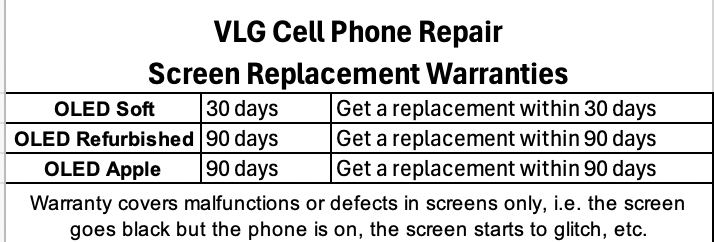When your phone screen cracks or malfunctions, you’ll likely face the decision of replacing it. One of the main choices is whether to go for an LCD or an OLED replacement. Both types of displays have their pros and cons, and understanding the differences can help you make an informed decision.
Fortunately, VLG Cell Phone Repair offers 30-day warranties on both LCD and OLED screen replacements, so that’s one decision you won’t have to make.
To learn more about other factors you need to consider when deciding which screen option to choose, see our list below.
What is an LCD Screen?
LCD stands for Liquid Crystal Display. These screens use liquid crystals between two layers of glass or plastic. The liquid crystals don’t emit light on their own. Instead, they rely on a backlight to make the display visible. The backlight is usually made of LEDs (Light Emitting Diodes), which shine through the liquid crystals to create an image.
What is an OLED Screen?
OLED stands for Organic Light Emitting Diode. Unlike LCDs, OLED screens don’t need a backlight. Instead, each individual pixel emits its own light. This self-lighting feature allows for deeper blacks and higher contrast ratios. OLED screens also tend to be thinner and more flexible than LCDs, making them ideal for modern, sleek designs.
Key Differences Between LCD and OLED
1. Display Quality
LCD screens offer good brightness and clarity. However, they can struggle with black levels. Since the backlight shines through all pixels, black pixels appear as dark gray instead of true black. OLED screens, on the other hand, deliver better contrast. Since each pixel lights up individually, black pixels are completely dark. This results in stunning image quality, with more vivid colors and deeper blacks.
2. Brightness
While both LCD and OLED screens are bright enough for everyday use, LCD screens typically have a higher peak brightness. This makes them more visible in direct sunlight. OLED displays, however, have excellent color saturation and can maintain brightness well in normal lighting conditions. In extreme sunlight, however, OLED may be slightly harder to read than an LCD.
3. Battery Life
Since OLED screens only light up individual pixels, they consume less power when displaying dark images. On the other hand, LCD screens have a constant backlight, so they tend to use more power, especially when showing bright images. As a result, phones with OLED displays can have better battery efficiency, especially when using apps with dark modes.
4. Durability
LCD screens are generally more durable than OLEDs when it comes to physical damage. This is because the backlight in an LCD adds an extra layer of protection. OLED displays, on the other hand, are more prone to burn-in. Burn-in happens when static images leave a permanent mark on the screen. This issue is less common with modern OLED displays, but it still occurs under heavy use.
5. Cost
OLED screens are more expensive to produce than LCD screens. This means replacing an OLED screen can be pricier, often costing more than an LCD replacement. If you’re on a budget and the display quality difference isn’t crucial to you, choosing an LCD replacement can save money.
6. Repairability
LCD screens are often easier and less expensive to repair. Since they have a separate backlight layer, replacing them is a simpler process. OLED screens require more precise handling, as the pixels are directly embedded into the display layer. This makes OLED repairs more complex, which adds to the overall cost.
Which is Better for You?
Choosing between an LCD or OLED replacement largely depends on your needs and budget.
– If you want the best display quality, vivid colors, and deep blacks, OLED is the way to go. The overall viewing experience is superior, especially for media consumption.
– If you’re on a budget, prefer durability, and don’t mind sacrificing some display quality, an LCD screen replacement can serve you well. They’re still capable of delivering a clear, bright display.
Conclusion
LCD and OLED screens each have distinct advantages. OLED offers superior display quality, power efficiency, and design flexibility. LCD screens, on the other hand, tend to be more affordable, durable, and easier to repair. Knowing the differences between the two can help you make the right choice when replacing your cell phone screen.

